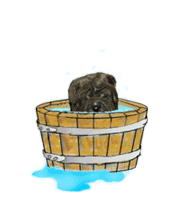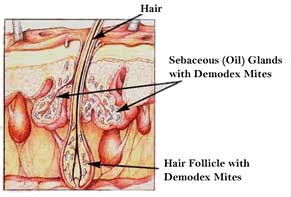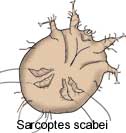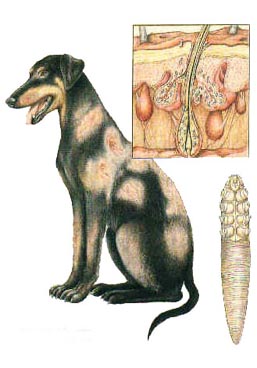|
Sharpei |
 |
|
 |
 |
Demodectic
Mange
(Demodex)
|
|
|
|
|
|
There are
two common types of mange that affect pets:
Demodectic Mange and Sarcoptic Mange
are both types of mange are caused by microscopic mites that
burrow under the skin of your pet...
Demodectic Mange
is more serious due to its ability to spread quickly and because
it is much harder to treat. This mite burrows into the skin of
your pet, attacking the hair follicle which can result in major
hair loss. Your pet's immune system tries to fight off the
invading mite, which results in major inflammation with
"pustules", bloody lesions and scabs. While quite nasty for your
pet, this type of mange can't be passed on to the pet owner. As
you can see these mites, Demodex canis & cati are tiny (less
than a hair width) and can only be seen under a microscope.
Beware of the well meaning, but unknowledgeable
novice who suggests everything from yoghourt to dancing in the
early morning dew to cure Demodectic mange.....Early
Veterinary treatment for Demodectic
mange is critical
as it can require a long and difficult treatment program... |
Demodex Mite...Skin Section |
 |

|
Sarcoptic Mange
is the less
serious, but more highly transmittable type of
mange. Sarcoptic mange, otherwise known as "Scabies," has
zoo tonic potential, meaning that in addition to other sources,
you can get it from your pet! (in the unlikely event that you
get it, a solution from a pharmacy, applied a couple of times
after a bath/shower gets rid of it) The mite's motion while burrowing
into and moving on top of the skin causes extreme itching
followed by flaky or scabby dandruff and loss of hair. Sarcoptic
mange is much easier to cure than Demodectic mange because the
Sarcoptic mite doesn't burrow deep into the skin of your pet!
... |
|
|
Demodecosis is an inflammatory parasitic disease of dogs,...,
characterized by the presence of a high number of mites in the hair
follicles, which often leads to inflammation and infection. The mite, Demodex, is part of the normal make up of the skin and is normally present
in small number. The mite resides in hair follicles and glands surrounding
the follicles (sebaceous glands). Due to changes in either the genetic or
immune system of the animal, the mite begins to proliferate and causes the
clinical signs of the disease.
CANINE DEMODEX
Most cases in dogs occur at a young age. There are no sex or breed
predilections. Transmission occurs by direct contact from the bitch to
nursing neonates during the first two or three days of neonatal life.
Puppies delivered by caesarean section and raised away from the infected
carriers mother do not develop the disease. Adult onset Demodex may be
due to a decreased resistance to the mite as a result of a compromise of
the immune system. It is speculated that some internal disease may cause immuno-suppression. The feeling is that there is a subnormal percentage of
interlukin-2 receptors on certain blood cells called lymphocytes. In adult
onset mange, owners should be aware of the possibility of a major internal
illness or a malignant cancer.
CLINICAL SIGNS
Localized Demodex
Signs are usually mild and one to several patches of hair loss and
inflammation are noted. The most common sites are the face and fore legs.
Most cases heal with less then 10% progressing to generalized Demodecosis.
Generalized Demodecosis
There are many lesions. These are reddened patches and may be itchy.
Secondary bacterial infections occur as the numbers of mites proliferate.
Differential diagnosis includes primary bacterial infection, fungal
infections, contact dermatitis,
and immune mediated skin diseases.
TREATMENT
Localized Demodex
If mild, the disease usually heals spontaneously. Topical treatment a
diluted amitraz (3ml to 30 ml of mineral oil), or rotenone may be used.
After four weeks of treatment the numbers of mites should be greatly
reduced. If more mites are observed then the condition should be treated
as a generalized form.
Generalized Demodex
Adult onset forms may become a management problem due to an underlying
cause. Many of these animals may be medically controlled rather than
cured. The prognosis is dependent upon the genetic, immunologic, and
underlying disease.
Juvenile forms are treated by the following medications.
(Great care should be taken when bathing as described below and we
recommend that it is only carried out by an experienced person or vet!)
Amitraz (Mitaban-Upjohn) is the first line in the treatment. Dosage and
regimen: use weekly to every other week. Apply a protective ophthalmic
ointment to the eye. Wash the entire dog with an antibacterial shampoo,
and gently towel dry the pet. Then apply the amitraz. Use either weekly or
every other week.
Mix ½ vial per gallon of water. Apply to the entire
body. Wear protective gloves when applying.
This medication may cause transitory sedation for 12-24 hours. We
recommend keeping your pet confined during the day of treatment. Do not
towel dry, but let your pet air-dry...
An antibiotic should also be used to control secondary skin infections.
Continue treatment until two successive bi-weekly skin scrapings are
negative for the mite.
Animals which have
recovered should be excluded from breeding!
Other treatments include Ivermectin and Interceptor.(not licenced to use
on dogs in the UK)
In the
UK a new product - Selamectin - has just been licensed for this and other
uses.
It is contra-indicated to use corticosteroids in patients with Demodecosis.
Steroids are immunosuppressive. |
| |
|
|
| |
Demodex |
|
|
Therapeutic Plan
Topical keratolytic
agents
Antibacterials
Topical drugs to kill the mite
|

Demodex is part of the
normal skin fauna and is usually present in small numbers in healthy
animals |
The entire
life cycle is spent on the host in the hair follicles or sebaceous glands |
|
Adult
Demodex Mite
 |
|
Dietary Plan
A diet suitable for
tissue repair
A diet based on
individual patient evaluation, including body condition and other organ
system involvement in the disease |
|
Diagnostic Plan
History
Physical Examination
Skin Scrape
Skin Biopsy
Skin Culture |
![]()